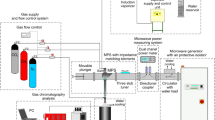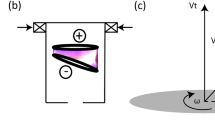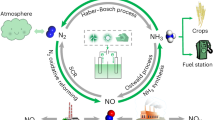Abstract
THE synthesis of hydrazine from ammonia in the silent discharge was first reported by Besson1. Subsequent investigations by other workers on flowing systems2,3 only led to both low conversion and very low hydrazine yields being obtained. The yields are normally expressed as grams of hydrazine per kilowatt hour of energy dissipated in the actual discharge. More recent work claims substantially increased yields by withdrawal from the discharge of the desired product in an absorbent4. A reasonable working explanation for the increase in yield reported in this case could well be as follows. The reactions in the discharge are undoubtedly of a very complex nature probably consisting of a series of competing formation and degradation reactions for any particular species in the discharge. The use of an absorbent is equivalent to reducing the residence time of the chemical species in the discharge, that is, it reduces the possibility of its decomposition by either further electron bombardment or other collision phenomena. Ideally, the absorbent would be selective only for the product and allow the activation reactions to take place virtually unhindered by its presence. Furthermore, if the effect of the absorbent is assumed to be entirely physical in nature, it follows that any method of reducing the residence time of the product in the discharge would be expected to enhance yields. Other possible methods of achieving this same end are increased flow rate, pulsing of the discharge or removal of product by condensation, adsorption or chemical combination.
This is a preview of subscription content, access via your institution
Access options
Subscribe to this journal
Receive 51 print issues and online access
$199.00 per year
only $3.90 per issue
Buy this article
- Purchase on Springer Link
- Instant access to full article PDF
Prices may be subject to local taxes which are calculated during checkout
Similar content being viewed by others
References
Besson, A., Compt. Rend., 152, 1850 (1911).
Bredig, G., Koenig, A., and Wagner, O. H., Z. Phys. Chem., 139 A, 211 (1928).
Devins, J. C., and Burton, M. J., J. Amer. Chem. Soc., 76, 2618 (1954).
Brit. Pat. 948,772; 958,776–8; 966,406 (1964).
Ouchi, A., J. Electrochem. Soc. Japan, 17, 285 (1949); ibid., 20, 164, 168, 378 (1952).
Author information
Authors and Affiliations
Rights and permissions
About this article
Cite this article
THORNTON, J., SPEDDING, P. Hydrazine Synthesis in the Silent Electrical Discharge. Nature 213, 1118–1119 (1967). https://doi.org/10.1038/2131118b0
Received:
Published:
Issue Date:
DOI: https://doi.org/10.1038/2131118b0
Comments
By submitting a comment you agree to abide by our Terms and Community Guidelines. If you find something abusive or that does not comply with our terms or guidelines please flag it as inappropriate.



